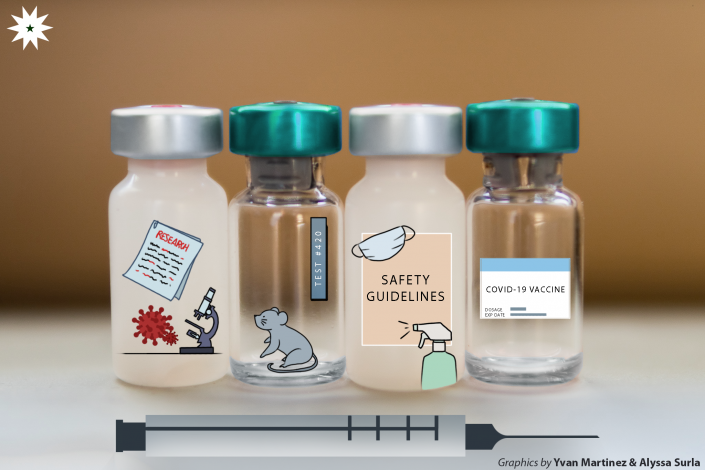To protect against certain infectious diseases, the immune system must be able to recognize and attack certain pathogens or disease-causing microorganisms. This can typically be acquired through either natural immunity—where one contracts the disease, generates a sufficient immune response, and remembers how to fight it—or vaccination, a type of medical intervention that aims to train the immune system to recognize these pathogens and prevent infection without supposedly getting sick.
According to the World Health Organization (WHO), immunization via vaccination currently prevents two to three million deaths every year. However, there still is public distrust surrounding vaccines, especially after the Dengvaxia controversy; even as Filipinos fear contracting COVID-19, the huge amount of misinformation on the virus itself and on vaccination has aggravated both vaccine hesitancy and over-reliance on these vaccines. There are also questions over whether natural immunity can indeed be developed after recovering from the disease or how long said immunity would last to protect against reinfection—making the development of effective vaccines, and understanding this process, even more important.
Familiar phases
Vaccines go through rigorous development and regulation processes, involving several stages of testing to ensure their effectiveness and safety for use. The whole process would normally take between 10 to 15 years, with the fastest one being the mumps vaccine, which was developed in only four years.
However, in a report by the Council of Foreign Relations (CFR), experts suggest that a COVID-19 vaccine could be available in only 12 to 18 months, with the World Health Organization (WHO) approving an accelerated process of vaccine development. This fast-tracked process has been made possible by the amount of resources dedicated to COVID-19 vaccines and by overlapping the different stages involved, while importantly still adhering to stringent testing standards.
Scientists begin with the exploratory phase, a research-intensive stage that typically involves comparing the virus’ structures with “the structures of other viruses with existing vaccines,” explains Biology Department Associate Professor Dr. Chona Abeledo. This was elucidated much faster for SARS-CoV-2, the virus that causes COVID-19, as researchers were able to sequence its genetic material and determine its surface protein structures as early as February.
According to Dr. Salvador Caoili, an associate professor from the University of the Philippines College of Medicine, the next stage is “a preclinical phase of experiments in live animals” to test a vaccine candidate’s immunogenicity or its ability to provoke an immune response.
If successful, the vaccine candidate moves to the clinical trial stage composed of a series of four successive phases, Caoili describes. The vaccine is tested on progressively larger numbers of human participants—going from around 20 initially to several thousand from diverse demographic backgrounds in Phase III—to determine the extent of the vaccine’s safety and immunogenicity, as well as possible short term and long term complications. Pharmaceutical companies also evaluate dosage requirements and the durability of the vaccine, or how long the immunity could last.
After the clinical trials, the vaccine will have to be approved by different regulatory bodies such as the Philippines’ Food and Drug Administration (FDA). Usually, manufacturing starts after the vaccine candidate is approved before Phase IV trials, where the vaccine’s effectiveness and safety is continuously observed while being used for the general population. In COVID-19’s case, starting manufacturing based on promising results from clinical trials without necessarily waiting for FDA approval, as done by Moderna, can allow faster procurement of the vaccine.
Even if there are successful vaccine candidates, there are still issues concerning which populations to prioritize and if enough can be distributed. CFR notes that “an estimated one billion doses would need to be manufactured just to vaccinate workers in health care and other essential industries globally, and that is if only a single dose is required for each person.”

Action in citizenry
While Caoili states that “it may still be too early to claim that the development of any particular vaccine is close to completion,” the Draft landscape of COVID-19 candidate vaccines published by WHO may provide insight for potential vaccines. This freely accessible publication features vaccine candidates in their preclinical stages—like those manufactured by Osaka University and the Karolinska Institute—as well as vaccines in their clinical evaluation phase, produced by pharmaceutical companies Sanofi and Moderna. WHO’s draft landscape allows the assessment of how far development has advanced with respect to human trials.
As the collective effort to find a viable vaccine proceeds, news reports of success may be contentious. With this, Abeledo expresses her concern about the “possibility of shortcuts being done”, such as administering shots as a “pre-test” to human participants without proper consent and proceeding with trials despite questionable data, when the vaccine development pipeline requires stages of thorough trials and strict regulation.
Beyond the role of scientific research and discovery, each individual has the capacity to be an agent for social change and to participate in building a more equipped community against COVID-19. For Abeledo, she believes support for vaccine development can be achieved through volunteering for testing, under the provision that these trials are highly regulated and administered by a network of experts in infectious disease. She adheres to emphasizing the importance of scientific literacy demonstrated by preventing the spread of misinformation. Similarly, Caoili suggests that life during the COVID-19 pandemic may urge people to “perform work that supports vaccine development initiatives” and advocate for “adequate funding of academic research” to fuel the foundations of its processes.
Vaccine approval and distribution may not ensure the immediate return to normalcy, but it does provide opportunities to demonstrate active citizenship. Communities can enhance virus response through basic hygiene and health protocols, instilling empathy for our healthcare workers and combating misinformation instead of idly waiting. Individuals hold the potential to catalyze an effective response to a public health crisis, strengthening the need for knowledge in a world now paralyzed and confused. As the race for a vaccine continues, it is important that societies accept the scientific foundations that govern its development.
